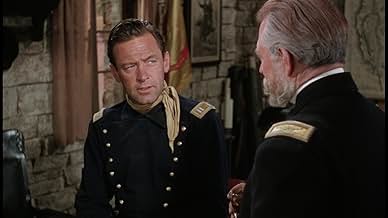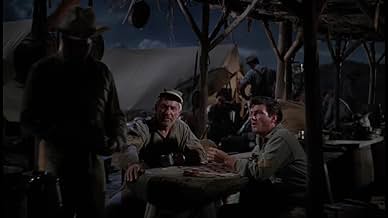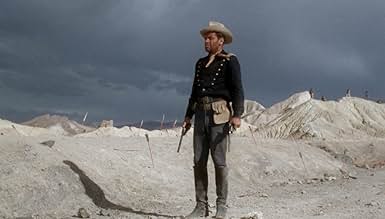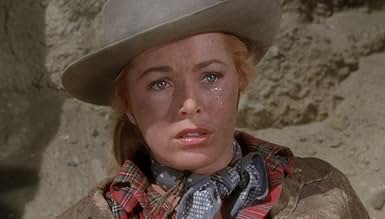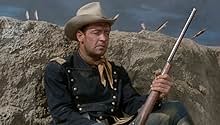IMDb-BEWERTUNG
6,6/10
3324
IHRE BEWERTUNG
Jeder südlichen Rebellen, die vom Remote-Gefängnis Union Fort Bravo entfliehen will, muss durch die endlose Wüste von Arizona Territory vorbei und erwarten kein Mitleid.Jeder südlichen Rebellen, die vom Remote-Gefängnis Union Fort Bravo entfliehen will, muss durch die endlose Wüste von Arizona Territory vorbei und erwarten kein Mitleid.Jeder südlichen Rebellen, die vom Remote-Gefängnis Union Fort Bravo entfliehen will, muss durch die endlose Wüste von Arizona Territory vorbei und erwarten kein Mitleid.
- Regie
- Drehbuch
- Hauptbesetzung
Carl Andre
- Trooper
- (Nicht genannt)
Walter Bacon
- Confederate Prisoner
- (Nicht genannt)
Richard P. Beedle
- Confederate Lieutenant
- (Nicht genannt)
Arthur Berkeley
- Confederate Prisoner
- (Nicht genannt)
Chet Brandenburg
- Confederate Prisoner
- (Nicht genannt)
Harry Cheshire
- Chaplain
- (Nicht genannt)
Tom Coleman
- Confederate Prisoner
- (Nicht genannt)
Sayre Dearing
- Confederate Prisoner
- (Nicht genannt)
Empfohlene Bewertungen
In 1863, with the American Civil War raging, a prison camp has been set up to house Confederate prisoners deep in the Arizona Territory. This is the eponymous Fort Bravo.
Resentful of captivity, the Southern prisoners remain in a constant state of unrest, and escape bids are common. However, the hostile remoteness of the terrain and the vigilance of the Union's Captain Roper make a successful breakout virtually impossible. Beyond the sheer physical obstacles barring the path to freedom lie the ferocious Mescalero indians.
Roper is "the man that's always after people". A stern martinet, he holds it to be a matter of honour that every escapee shall be found and dragged back. He is hated by the prisoners, and though some of his own side dislike his methods, he is respected as an efficient and reliable officer.
There is a void in Roper's life. He needs love. "You've a big fist inside you that's always doubled up," he is told. For all his attention to duty, Roper is deeply unhappy. Then the beautiful Carla Forrester arrives at Fort Bravo ...
The film has a marvellous look. Shot by director of photography Robert Surtees on bright, sundrenched locations and developed in a process called Ansco Color (a new one on me - though that's not saying much), the movie is a feast for the eye. Creamy yellow sand and tawny hills form beautiful backgrounds against which the blue cavalry uniforms stand out magnificently. When Roper and Carla go for their romantic horseride, there is a vast sky above their heads. The shots of the indian riders circling the beleaguered cavalry troopers are gorgeous. At the climax of the film a small group Fort Bravo people is pinned down by the indians in a shallow depression in the sand, and yet again the look of the images is quite simply stunning. Warren Newcombe's special effects include volleys of indian arrows cascading down on the Fort Bravo party in arcs of hissing death.
There are one or two quibbles. Is a troop of cavalrymen the proper unit to garrison a prisoner of war camp? Would a mobile detail which was expecting to be ambushed really ride through a steep canyon? Surely the waltz playing at the fort social event - "The Mountains of Mourne" - is an anachronism? My guess is, the tune wasn't composed until fifty years after this. The 'night in the desert' passages are patently filmed in the studio - a great shame, considering the beauty of the location shots.
William Holden is at his tight-lipped, angry best as Captain Roper. Eleanor Parker looks divine as the improbable Carla. The trio of likeable Confederates, Marsh, Young and Campbell (played by John Forsythe, William Campbell and William Demarest resectively) doesn't quite come off as a comedy sub-plot.
The film is a good cavalry-and-indians caper, with Holden carrying most of it on his capable shoulders. There is even a hint of character development, as Roper learns eventually that "there's something better than being tough."
Resentful of captivity, the Southern prisoners remain in a constant state of unrest, and escape bids are common. However, the hostile remoteness of the terrain and the vigilance of the Union's Captain Roper make a successful breakout virtually impossible. Beyond the sheer physical obstacles barring the path to freedom lie the ferocious Mescalero indians.
Roper is "the man that's always after people". A stern martinet, he holds it to be a matter of honour that every escapee shall be found and dragged back. He is hated by the prisoners, and though some of his own side dislike his methods, he is respected as an efficient and reliable officer.
There is a void in Roper's life. He needs love. "You've a big fist inside you that's always doubled up," he is told. For all his attention to duty, Roper is deeply unhappy. Then the beautiful Carla Forrester arrives at Fort Bravo ...
The film has a marvellous look. Shot by director of photography Robert Surtees on bright, sundrenched locations and developed in a process called Ansco Color (a new one on me - though that's not saying much), the movie is a feast for the eye. Creamy yellow sand and tawny hills form beautiful backgrounds against which the blue cavalry uniforms stand out magnificently. When Roper and Carla go for their romantic horseride, there is a vast sky above their heads. The shots of the indian riders circling the beleaguered cavalry troopers are gorgeous. At the climax of the film a small group Fort Bravo people is pinned down by the indians in a shallow depression in the sand, and yet again the look of the images is quite simply stunning. Warren Newcombe's special effects include volleys of indian arrows cascading down on the Fort Bravo party in arcs of hissing death.
There are one or two quibbles. Is a troop of cavalrymen the proper unit to garrison a prisoner of war camp? Would a mobile detail which was expecting to be ambushed really ride through a steep canyon? Surely the waltz playing at the fort social event - "The Mountains of Mourne" - is an anachronism? My guess is, the tune wasn't composed until fifty years after this. The 'night in the desert' passages are patently filmed in the studio - a great shame, considering the beauty of the location shots.
William Holden is at his tight-lipped, angry best as Captain Roper. Eleanor Parker looks divine as the improbable Carla. The trio of likeable Confederates, Marsh, Young and Campbell (played by John Forsythe, William Campbell and William Demarest resectively) doesn't quite come off as a comedy sub-plot.
The film is a good cavalry-and-indians caper, with Holden carrying most of it on his capable shoulders. There is even a hint of character development, as Roper learns eventually that "there's something better than being tough."
It's an interesting western/prison movie cross-over, although above all the movie remains a western of course with some of its formulaic ingredients, in this movie it's mostly the use of Indians. The story makes the movie more original than most of the other western's from the '50's. It's originality also help to make this movie a better than average one.
Of course the story still feels the need to put in a love-story into the movie but that's basically the curse of every movie that's over 50 years old. Nevertheless the love-story itself is also quite different and original, so it isn't as distracting as in most other genre movies from the same period often was the case.
Director John Sturges has made many entertaining and adventurous movies in his career and I consider this as one of them, though it obviously is not his best work. It's just a good and enjoyable movie, with some real great moments, for in between.
At times its painfully obvious that the movie was for some part shot in studios with fake looking backgrounds in it. It makes the movie look outdated but that also by now has become part of the charm of these sort of movies. The cinematography is from Robert Surtees, who perhaps was the greatest cinematographer of his time. This movie isn't his best done however but it's a worthy one.
William Holden is good in his role, though it's hard to always like him because of the stubbornness and seemingly lack of emotion of the character. The supporting cast also pull of well, especially John Forsythe.
The musical score by Jeff Alexander is surprisingly great and I mean really great. It's not the usual some old, same old '50's western drivel. It's a score worth searching out, though I don't think it's available anywhere.
An enjoyable movie to watch, that's worth watching if you get the chance.
7/10
http://bobafett1138.blogspot.com/
Of course the story still feels the need to put in a love-story into the movie but that's basically the curse of every movie that's over 50 years old. Nevertheless the love-story itself is also quite different and original, so it isn't as distracting as in most other genre movies from the same period often was the case.
Director John Sturges has made many entertaining and adventurous movies in his career and I consider this as one of them, though it obviously is not his best work. It's just a good and enjoyable movie, with some real great moments, for in between.
At times its painfully obvious that the movie was for some part shot in studios with fake looking backgrounds in it. It makes the movie look outdated but that also by now has become part of the charm of these sort of movies. The cinematography is from Robert Surtees, who perhaps was the greatest cinematographer of his time. This movie isn't his best done however but it's a worthy one.
William Holden is good in his role, though it's hard to always like him because of the stubbornness and seemingly lack of emotion of the character. The supporting cast also pull of well, especially John Forsythe.
The musical score by Jeff Alexander is surprisingly great and I mean really great. It's not the usual some old, same old '50's western drivel. It's a score worth searching out, though I don't think it's available anywhere.
An enjoyable movie to watch, that's worth watching if you get the chance.
7/10
http://bobafett1138.blogspot.com/
A civil war era western set in Arizone stockade . During the Civil War , a group of Confederates are ruthlessly guarded by a hard-bitten cavalry officer , the pivotal role captain Roper (William Holden) . In the meantime , local Indian tribes are restive and the rebel prisoners try to getaway from captivity . Then , the rebel leader Capt. John Marsh (John Forsythe) accompanied by his underlings , the old Campbell (William Demarest) , the impetuous Young Cabot Young (William Campbell) and the coward Bailey (John Lupton) escape from the Union POW camp at Fort Bravo but has to contend with the desert , the Mescalero Indians and the pursuing Union troops . Along the way the suspect Carla Forester (Eleanor Parker) , a wedding visitor , is soon ensnared by seducing Roper from his duty . When the commander discovers what's happened , a tense hunt ensues throughout the stark outdoors , as Roper chases mercilessly his prisoners . There takes place a tense pursuit across enemy territory extremely surrounded by hostile Indians and being assailed by wave upon wave into the rugged landscape of Arizona .
It is a classic and old tale with excellent action set pieces skillfully worked , lots of action , well-executed , good performance all around and a big finish with assorted Indian parties making use of their relentless arcs and arrows . Slow-moving at the beginning , the flick works up to a breathtaking final when the group to be beset by hostile as well as unstoppable Indians . That's why there stand out the thrilling and surprising scenes when the main roles are trapped in the dangerous contours of Death Valley by hostile Mescalero Indians shooting killing arrows while attempting to get everyone back to the fort . Main and support players are frankly top-notch , delivering enjoyable interpretations from a cast headed by Holden , Forsythe and Parker . Nice acting by William Holden as hard-nosed officer and giving audiences one of their best looks . And awesome Eleanor Parker as a gorgeous Southern spy whose job is to break the Confederate prisoners out of jail . Support cast is frankly excellent , plenty of familiar faces , such as : Polly Bergen , Richard Anderson , Carl Benton Reid , John Lupton , Alex Montoya and uncredited Glenn Strange . Colorful and sunny cinematography by Robert Surtees , subsequently an expert cameraman of super-productions , this was planned to be filmed in 3D , but was eventually filmed in 2D, the first feature to employ spherical Panavision lenses . Being shot on location in Corriganville, Ray Corrigan Ranch , Simi Valley , California , Gallup, New Mexico, and Death Valley National Park , California . Atmospheric and stirring musical sore by Jeff Alexander , including some wonderful songs .
The motion picture was compelling and forcefully directed , thanks capable hands of filmmaker John Sturges . The redoubtable John demonstrates his skill and mettle here . Sturges was a warlike genre expert (Great escape , Never so few , The Eagle has landed) and Western master (Gunfight OK Corral , Last train of Gun Hill , The law and Jake Wade , Magnificent Seven). Escape from Fort Bravo rating: 7/10 , better than average . Well worth seeing , the movie will appeal to William Holden fans .
It is a classic and old tale with excellent action set pieces skillfully worked , lots of action , well-executed , good performance all around and a big finish with assorted Indian parties making use of their relentless arcs and arrows . Slow-moving at the beginning , the flick works up to a breathtaking final when the group to be beset by hostile as well as unstoppable Indians . That's why there stand out the thrilling and surprising scenes when the main roles are trapped in the dangerous contours of Death Valley by hostile Mescalero Indians shooting killing arrows while attempting to get everyone back to the fort . Main and support players are frankly top-notch , delivering enjoyable interpretations from a cast headed by Holden , Forsythe and Parker . Nice acting by William Holden as hard-nosed officer and giving audiences one of their best looks . And awesome Eleanor Parker as a gorgeous Southern spy whose job is to break the Confederate prisoners out of jail . Support cast is frankly excellent , plenty of familiar faces , such as : Polly Bergen , Richard Anderson , Carl Benton Reid , John Lupton , Alex Montoya and uncredited Glenn Strange . Colorful and sunny cinematography by Robert Surtees , subsequently an expert cameraman of super-productions , this was planned to be filmed in 3D , but was eventually filmed in 2D, the first feature to employ spherical Panavision lenses . Being shot on location in Corriganville, Ray Corrigan Ranch , Simi Valley , California , Gallup, New Mexico, and Death Valley National Park , California . Atmospheric and stirring musical sore by Jeff Alexander , including some wonderful songs .
The motion picture was compelling and forcefully directed , thanks capable hands of filmmaker John Sturges . The redoubtable John demonstrates his skill and mettle here . Sturges was a warlike genre expert (Great escape , Never so few , The Eagle has landed) and Western master (Gunfight OK Corral , Last train of Gun Hill , The law and Jake Wade , Magnificent Seven). Escape from Fort Bravo rating: 7/10 , better than average . Well worth seeing , the movie will appeal to William Holden fans .
William Holden's character, in the Civil War-era Western "Escape From Fort Bravo" (1953), has a very appropriate name. When we first see his Capt. Roper, he is dragging an escaped Confederate prisoner, by rope, across the desert; a not-so-subtle warning to any other rebs who might be planning a similar break from the Union fort, deep in the Arizona Territory. But when that escape comes, led by Southern Capt. Marsh (John Forsythe) and abetted by Texan belle Carla Forester (Eleanor Parker), Roper is forced to follow the fugitives...even though the path leads straight into the country of the bloodthirsty Mescalero Apaches. Filmed in Death Valley National Monument and in gorgeous color, "Escape From Fort Bravo" showcases some truly spectacular scenery, not the least of which is Eleanor herself. One of the 1950s' most gorgeous of actresses, she looks absolutely ravishing here, her famous red hair a wonder to behold. She would also appear the next year in another film--"The Naked Jungle"--featuring man-eating ants. (Oh, did I forget to mention that those Mescaleros have a nasty habit of tying their prisoners to ant hills?) "Escape" boasts a very tough-talking script, with glints of humor coming from the bickerings between (those great character actors) Williams Demarest and Campbell, and its final third is remarkably suspenseful, as Roper, Carla and the escaped rebs are laid siege in a ditch, while the Mescaleros pick them off with rifle shot and lob volleys of arrows into their midst. Director John Sturges would go on to make three more classic Westerns over the next seven years ("Gunfight at the O.K. Corral," "Last Train From Gun Hill" and, of course, "The Magnificent Seven"), and here turns what is basically a "cavalry and Injuns pic" into a thing of real beauty and excitement. Yes, I really did enjoy this one.
During the Civil War, Union captain at an Arizona fort chases down a group of deserters on their way to Texas (including the woman the captain loves, who aided in the band's escape), but all involved become trapped in a desert trench by bloodthirsty Indians. Director John Sturges' 18th film looks pretty fantastic when it ventures outside due to Robert Surtees' robust cinematography; however, the MGM production suffers visually when mixing location shots with exterior scenes filmed indoors (this despite foliage and a waterfall to compliment a fight sequence). Sturges keeps a fast pace, though the picture isn't tightly-wound; the narrative is episodic and drifts, with only William Holden's deeply-felt work in the lead to hold most of it together. Holden's captain, who rarely smiles and seldom has emotions, evolves into a strong, loyal character--he's the heart of this piece. I'm not sure how well-matched the actor is with Eleanor Parker (who does her usual blank-eyed, open-mouthed silent suffering), however his declaration of love for her is convincing, thanks to Holden's sincerity. The bravura third act heats up with tense excitement as the Indians close in. This is where Sturges really comes to the fore and shows what he can do with familiar material. **1/2 from ****
Wusstest du schon
- WissenswertesThe small pistol Carla has is called a pepperbox (or pepperpot). Each barrel is loaded individually and has to be manually rotated to be fired. These types of guns were invented in the 1830s and predate the modern revolver by just a few years.
- PatzerCapt. Roper is in a gunfight in Death Valley and is shot in the left shoulder. When riding into town his right arm is in a sling.
- Zitate
Cabot Young: How did a decrepit old man like you ever get in the war?
Campbell: Because all the smart young men like you was losing it.
- VerbindungenEdited into Durch die Hölle nach Westen (1976)
- SoundtracksYellow Stripes
Written by Stan Jones
Top-Auswahl
Melde dich zum Bewerten an und greife auf die Watchlist für personalisierte Empfehlungen zu.
- How long is Escape from Fort Bravo?Powered by Alexa
Details
Box Office
- Budget
- 1.520.000 $ (geschätzt)
- Laufzeit1 Stunde 39 Minuten
- Seitenverhältnis
- 1.66 : 1
- 1.75 : 1
- 1.37 : 1
Zu dieser Seite beitragen
Bearbeitung vorschlagen oder fehlenden Inhalt hinzufügen

Oberste Lücke
By what name was Verrat im Fort Bravo (1953) officially released in India in English?
Antwort


